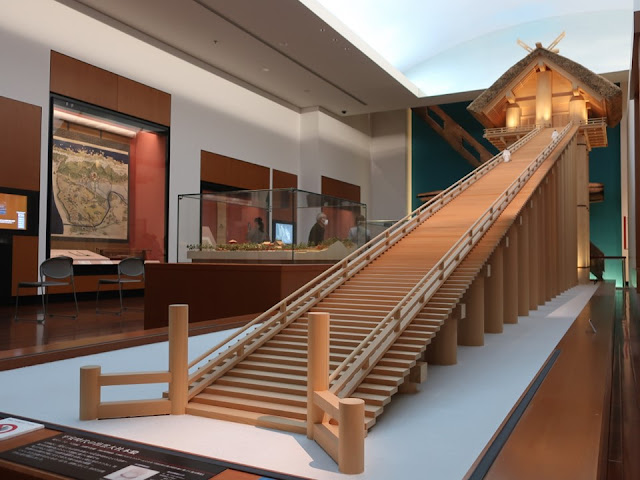Izumo in western Japan is very
particular for Japanese. The myth about the deity
(god) of Izumo is written in the oldest history book “Records of Ancient
Matters” which was compiled by Japanese dynasty in the 8th century. The
Izumo deity transferred the ruling power to Amaterasu (deity) who was said to
be the ancestor of emperor of Japan. The Izumo deity, whose name is
Ohkuninusi, is enshrined at Izumo Shrine or Izumo Ohyashiro.
The museum shows us not only the ancient
era but also modern one, so we can know fun things of all eras. I’d like to show
you Izumo Shrine at first which is next to the museum.
古代と名付けられていますが、現代も紹介されています。出雲地方の古代の楽しみ、現代の楽しみ、よく分かりました。まずは、博物館の重要な展示テーマでもある出雲大社(いずもたいしゃ、正式名称:いずもおおやしろ)を紹介します。博物館は出雲大社の隣りにあります。
There is a large tori gate at the entrance. I visited on the last day of the ritual, in which all deities in Japan gather.
出雲大社は大国主命を祭神とします。訪問したのは全国の神々が集まる神在祭の最終日でした。平日でしたがお参りが多かったと思います。
At the end of the long approach which is between the rows of pine trees, there is a front shrine (haiden) which is famous for its giant sacred straw rope.
長い松の参道の先に、巨大な注連縄で有名な拝殿があります。二礼四拍手一礼でお参りします。
We pray at the main hall from the gate. There were pillars on the circles. Parts of those massive pillars are exhibited at the museum.
ご本殿は八足門から参拝します。手前はかつての本殿の柱の跡です。柱は博物館に展示されています。
If you go back down, you can see the roof of the main hall (24m height).
門から少し離れると高さ24mのご本殿の屋根が見えます。
All deities come to Inasa beach on the 10th of October in lunar calendar. They stay here seven days and join the ritual (kami-ari-sai).
全国の神様がお越しになる稲佐の浜。旧暦10月10日に神迎えの神事が行われ、その後、七日間、神々は出雲に滞在し、神在祭が行われます。
Shimane Museum of Ancient Izumo、古代出雲歴史博物館
Excavated pillars of the ancient main hall, which was damaged over time, are exhibited at the hall of the museum. Three cedar pillars were banded and supported the main hall. It’s actually magnificent.
博物館のホールには発掘された古代の本殿の柱(直径1.3m)が展示されています。杉で、三本一組で使われていました。周囲は石で固められていました。確かに大木です。
The main hall (1/10 model) around a thousand years ago stands at the permanent exhibition room. It made me respect the Izumo deity; I guess all ancient people also respected the deity. However, I had a question whether they could truly build the hall or not.
常設展示室に入ると、平安時代の本殿の1/10モデルが迎えてくれます。神を敬う気持ちははるかに今より強かった時代とはいえ、本当に、高さ48mの本殿を作ったのかという印象です。
Five models of the main hall are exhibited; all of them were made based on theories. Anyway, I think the high-rise shrine attracted travelers and gave a good topic to them after returning their home.
五つの学説を元にしたモデルを置いているところが、学術的でありがたいです。いずれにせよ高層の建物。普通の人にとっては、見るだけで価値があった(土産話になった)と思います。
There was a special section about the meeting of deities from all over Japan. The deities gather at Izumo and have the meeting. The important item of the agenda is matchmaking; the Izumo deity (Ohkuninusi) is called “the deity of marriage and love”.
Pictures about the meeting have been made, and people have enjoyed seeing them. The pictures above were printed in the mid-18th century. Deities who look like Kabuki actors have the meeting which seems to be noisy.
出雲に集まった神々は男女の縁結びなど様々な話し合い(神議り/かみはかり)をします。大国主命は縁結びの神様として有名ですね。「神在月と縁結び」というミニ企画がありました(11/2~12/19)。
神話にちなんで、人々がいろいろな絵を作って楽しんでいます。写真は、神議りの錦絵(江戸後期)です。当時の歌舞伎役者の似顔絵になっているそうです。
縁結びの間違いが発覚して大騒ぎになったという絵です(1868)。買う人がいるから書く人(月岡芳年)がいました。幕末らしい混乱か、それともいつものことなのか。庶民のすることは明るいです。
Various practices regarding matchmaking and Izumo Shrine were exhibited. We could know people’s wish. The shells were picked up at Inasa Beach (lower right); those are called “en(encountering)-gai(shell)”. People pray those shells for making a good match.
縁結びや出雲大社にかかわる様々な風習が紹介されています。願いの気持ちが伝わってきます。縁貝(えんがい)は、稲佐の浜(右下)で拾った貝殻に良縁を願う風習です。
People take seawater at Inasa Beach by the bamboo container and offer the water to the deity. People pray for protecting against misfortune and so on.
潮汲み:災い除けや神在祭での願掛け、葬式の忌み明けとして、竹筒で稲佐の浜の海水を汲み神に捧げる風習です。稲佐の浜は特別ですね。
Making paper strings which put down the name of men and women, then they drew a string from each group (men and women) and tied them. It's a kind of love fortune-telling which was held in the Edo period (1603~1868).
宿世結(すくせむすび):江戸時代、あらかじめ男女の名前を書いたこより引いて結ぶ、恋占いゲーム。
The wooden boat has an interesting story. In 1781, a plague spread in Kouchi of Shikoku Island. The local people prayed for Izumo deity. Thereafter, the plague went away. People thanked to the deity, and loaded offering money on the boat, then floated it on the river. Strangely enough, the boat arrived at Inasa Beach. It was written that someone who found the boat probably brought it to Inasa, because Kouch is too away. It was a rustic prayer, I like.
面白い舟とその由来を記した掛け軸が展示されています。1781年(天明元年)、土佐で疫病が流行し、大国主命に祈りをささげたところ病は終息しました。御礼に賽銭を添えたこの舟(願開舟/がんびらきぶね)を川に流したところ稲佐の浜に漂着したとのこと。舟を見つけた誰かが浜に送り届けたのだろうと書かれていますが、素朴な祈りを感じますね。
Visited
in November, 2022
Official
website: https://www.izm.ed.jp/english/index.html
https://www.izm.ed.jp/ (in Japanese), accessed in April, 2023
Previous post (towns related to Iwami
Silver Mine): Tomokan @ Tomogaura and Yunotsu in Shimane、鞆館(鞆ヶ浦)と温泉津(ゆのつ)
Next post (from ancient era to hundred
years ago): Shimane Museum of Ancient Izumo (2/2)、古代出雲歴史博物館 part2














Comments
Post a Comment